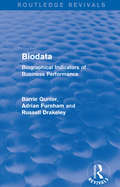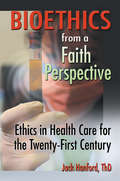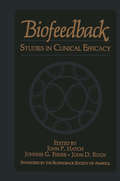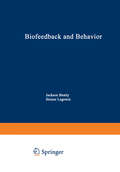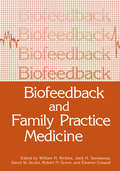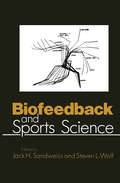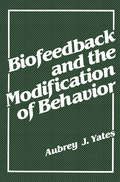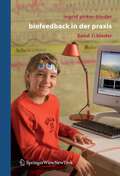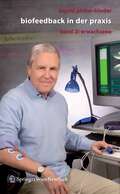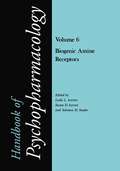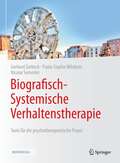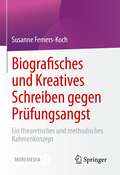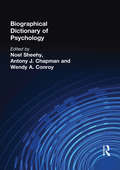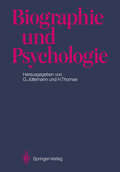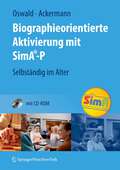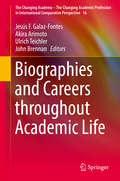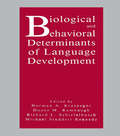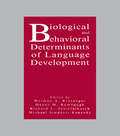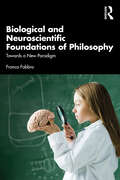- Table View
- List View
Biodata (Routledge Revivals): Biographical Indicators of Business Performance
by Barrie Gunter Adrian Furnham Russell DrakeleyFirst published in 1993. This book is intended for managers and occupational psychologists involved in the selection and assessment of the workforce. It details the history and development of the use of biographical data for both recruitment and promotion of employees. Grounded in relevant research literature, it offers a comprehensive analysis of the advantages and disadvantages of biodata in different contexts. It also includes examples of applications and recommendations for use, as well as examples of questionnaires. Written by experts, it represents a wide-ranging review of the contemporary research in the field. This work will be of interest to students of business and psychology.
Biodata (Routledge Revivals): Biographical Indicators of Business Performance
by Barrie Gunter Adrian Furnham Russell DrakeleyFirst published in 1993. This book is intended for managers and occupational psychologists involved in the selection and assessment of the workforce. It details the history and development of the use of biographical data for both recruitment and promotion of employees. Grounded in relevant research literature, it offers a comprehensive analysis of the advantages and disadvantages of biodata in different contexts. It also includes examples of applications and recommendations for use, as well as examples of questionnaires. Written by experts, it represents a wide-ranging review of the contemporary research in the field. This work will be of interest to students of business and psychology.
Bioethics from a Faith Perspective: Ethics in Health Care for the Twenty-First Century
by Jack T Hanford Harold G KoenigDiscover the spiritual community's position on bioethics issues!Bioethics from a Faith Perspective: Ethics in Health Care for the Twenty-First Century offers a meaningful, rational, faith-oriented framework for deciding how to deal with important biomedical health care issues. Organ donation, managed care, the Human Genome Project, and medical technology that keeps people alive beyond their “natural” life span are some of the topics it illuminates through case analysis and resolution. Since almost all textbooks in bioethics omit the religious dimension of life (even though the field was inspired and stimulated by religious scholars at Princeton and Yale), this is an indispensable volume.While most people state their moral positions from the background of their religious traditions, many have not had the opportunity to study the relation between their faith perspectives and the difficult issues that arise in the pursuit of health care. This book shows the relevance, significance, and guidance that a faith perspective can offer for dealing with bioethical issues.This unique and thoughtful book: shows you how to distinguish and describe the relation between technical and ethical aspects of health-related issues provides you with a framework of moral principles, theories, values, and faith viewpoints teaches you the defining characteristics of a moral professional-client relationship related to faith helps you to discern when medical ethics and faith commitments are therapeutic and when they are not gives examples describing a moral problem, a faith perspective, and a justified position on that problemSince bioethics has been an amazing story of growth from the 1950s to the present day and is still expanding, there will be changes. Bioethics from a Faith Perspective stimulates that expansion by including the religious dimension. It is the perfect supplement to the existing literature on the subject.
Bioethics from a Faith Perspective: Ethics in Health Care for the Twenty-First Century
by Jack T Hanford Harold G KoenigDiscover the spiritual community's position on bioethics issues!Bioethics from a Faith Perspective: Ethics in Health Care for the Twenty-First Century offers a meaningful, rational, faith-oriented framework for deciding how to deal with important biomedical health care issues. Organ donation, managed care, the Human Genome Project, and medical technology that keeps people alive beyond their “natural” life span are some of the topics it illuminates through case analysis and resolution. Since almost all textbooks in bioethics omit the religious dimension of life (even though the field was inspired and stimulated by religious scholars at Princeton and Yale), this is an indispensable volume.While most people state their moral positions from the background of their religious traditions, many have not had the opportunity to study the relation between their faith perspectives and the difficult issues that arise in the pursuit of health care. This book shows the relevance, significance, and guidance that a faith perspective can offer for dealing with bioethical issues.This unique and thoughtful book: shows you how to distinguish and describe the relation between technical and ethical aspects of health-related issues provides you with a framework of moral principles, theories, values, and faith viewpoints teaches you the defining characteristics of a moral professional-client relationship related to faith helps you to discern when medical ethics and faith commitments are therapeutic and when they are not gives examples describing a moral problem, a faith perspective, and a justified position on that problemSince bioethics has been an amazing story of growth from the 1950s to the present day and is still expanding, there will be changes. Bioethics from a Faith Perspective stimulates that expansion by including the religious dimension. It is the perfect supplement to the existing literature on the subject.
Biofeedback: Studies in Clinical Efficacy
by John P. Hatch, Johnnie G. Fisher and John D. RughThe chapters of this book were prepared as task force reports under the aegis of the Biofeedback Society of America (BSA). The impetus for the present generation of task force reports can be dated back to 1982, when John D. Rugh, as President-Elect of the Society, announced that the updating of the task force reports would be given high priority during his term as President. An ad hoc Task Force Committee was appointed in 1983, and the committee set the following objectives: (1) solicit a widely based stream of input from all segments of the Biofeedback Society of America, (2) establish a peer review system to assure the highest degree of scholarship and an unbiased approach, (3) select for area authors only individuals who have profound knowledge of the area and who have demonstrated the ability to extend understanding by reviewing and criticizing the literature, (4) prepare all reports according to a standard ized format, and (5) publish all the reports simultaneously. Input came from several sources. Many people responded with ideas and suggestions to an announcement in the BSA Newsletter that the task force reports were being revised. In 1984, a symposium was conducted at the BSA annual meeting, which included round table dis cussions and dialogues between task force report authors and the BSA membership.
Biofeedback and Behavior (Nato Conference Series #2)
by Jackson BeattyBiofeedback and Behavior: A NATO Symposium, held on 27-30 July 1976 at the Max Planck Institut fUr Psychiatrie in MUnchen, was a mul tidisciplinary meeting that explored both theoretical and applied issues arising from the use of biofeedback procedures for the control of visceral, central nervous system and skeletal events. The symposium was multi national in its composition. Financial support for the symposium was initially provided by the Scientific Affairs Division of the North Atlantic Treaty Organization as part of their continuing series of scientific symposia. Funds made avail able by a grant from the United States Office of Naval Research permit ted wide-spread international participation in the symposium. The facil ities for the meeting were graciously provided by the Max Planck Institut ilir Psychiatrie. We thank each of these organizations for their support in making this symposium possible. A special thanks is due to Dr. B.A. Bayraktar of the Scientific Affairs Division of NA TO and Dr. Donald Wood ward of the U.S. Office of Naval Research, whose counsel contributed substantially to the organization of this meeting. The planning of this symposium was carried out in consultation with members of the organizing committee: Rolf Engel, Pola Engel-Sittenfeld, Laverne C. Johnson, George H. Lawrence, Gary E. Schwartz, and Da vid Shapiro. The final form of this symposium reflects their contribu tions, for which we are grateful.
Biofeedback and Family Practice Medicine
by EleanorCriswell Robert N. Grove David W. Jacobs Jack H. Sandweiss William H. RicklesDuring the past five years there has been a reawakening of interest in the psychotherapy of patients with medical disorders characterized as psychosomatic. For three decades, psychoanalysis and psychoanalytic psychotherapy were used extensively to treat and study psychosomatic disorders. Early in the 1960s, interest in this approach to these conditions faded, and the ·Psychosomatic Service· in most hospitals became the ·Consultation Liaison Service· (Lipowski, 1967). The recent focus of biofeedback on psychosomatic conditions provides a new technique with which the physician or psychiatrist may treat these patients (Rickles, 1981). In addition, the successful application of biofeedback training to a variety of complaints such as those presented in this volume has heralded the addition of biofeedback to the treatment modalities used for medical complaints. Frequently, psychological factors can still be seen; for example, when biofeedback treatment may require lifestyle changes on the part of the patient, the exploration of secondary gains or resistances before the disorder can be success fully treated, and the establishment of rapport and empathy which is so important for truly effective biofeedback training. Aside from certain psychological dimensions that are always present in biofeed back training, in this case biofeedback is being used in a primarily medical setting for primarily medical complaints.
Biofeedback and Sports Science
by Steven L. Wolf Jack H. SandweissThere is a new breed of athletic coach in the educational arena. While on speaking engagements around the world, I've en couraged coaches to jump "head first" and quickly into sports science. The reason is simple. With new electronic commu nication systems coming on the market almost daily, athletes can get valid and reliable information to help them maximize sports skills, and this information can come faster than most coaches are able to deliver. Coaches have historically rejected most sports science efforts in favor of traditional"seat of the pants" systems, but now there is a new kind of athlete who is asking questions never before presented to the coach. Professional athletes are individually seeking out sports scientists for answers to their particular problems. Stories appear daily in the media about athletes making quantum jumps in performance as a result of their association with sports scientists. The tidal wave is building and no one can stop it-not even the sporting goods industry. "High-tech" athletic equipment is now a must in nearly every sport. Large sporting goods companies have nearly gone bankrupt because of competitors' new "high-tech" prod ucts. ix X FoREWORD The tail is wagging the dog. Professional, amateur, and weekend athletes alike are demanding technical answers of our sports leaders, and they are going elsewhere if the correct answers aren't available. The number of Olympic athletes visiting our Coto Research Center in California is staggering.
Biofeedback and the Modification of Behavior
by Aubrey J. YatesIn this book, I have attempted to evaluate critically the very large literature which has accumulated in the area of biofeedback over the past 10-15 years. As might be expected in any area of psychology with clinical possibilities, the literature divides itself into two main categories-fundamental research studies and therapeutic studies. It is now apparent that the clinical applications of biofeed back have far outstripped their fundamental research bases, with the inevitable result that the initial wave of enthusiasm may be replaced with an unnecessarily severe skepticism. Either extreme position is unjustified. Biofeedback does rep resent an important new approach to the elucidation of the role played by internal systems in the adjustment of the organism to its environment. But its potential will only be revealed if its use in practice is soundly based on fundamental research. There are promising signs that this is being realized so that there is cause for optimism. Aubrey J. Yates Perth, Australia A Note on the References With the exception of no more than two or three papers, all the references in this book have been obtained and read. However, many of them were published in journals which will not be readily accessible to the reader who may be interested in consulting more directly particular articles which attract his attention.
Biofeedback in der Praxis: Band 1: Kinder
by Ingrid Pirker-BinderGefühle wie Stress, Angst oder Freude verändern Herzrate, Atmung, Muskelspannung, Fingertemperatur und Hautleitwert. Biofeedback zeigt dies und fördert so die Selbstwahrnehmung und das Verständnis eigener Reaktionen. Kinder erlernen die Methode sehr schnell. Erstmalig bespricht dieses Buch wie sie auf Kinder angewendet werden kann. So z.B. beim Stressmanagement in Kindergarten oder Schule, bei Traumatisierungen, ADHD, ADD und in der Psychosomatik. Schritt für Schritt erklärt: das Therapiekonzept ASTI® für multimodales Biofeedback. Mit zahlreichen Übungsgeschichten: ein gelungenes Praxisbuch für Therapeuten, Trainer, Ärzte, Lehrer und Eltern.
Biofeedback in der Praxis: Band 2: Erwachsene
by Ingrid Pirker-BinderBiofeedback zeigt, wie der menschliche Körper auf Stress, Angst oder Freude durch die Veränderung der Herzschlagrate, Atmung, Muskelspannung, Fingertemperatur oder des Hautleitwertes reagiert. Praxisnah und anhand von Fallbeispielen veranschaulicht eine erfahrene Biofeedback-Spezialistin dessen Anwendung zur Erhaltung der Leistungsfähigkeit: im Sport, bei hoher Stressbelastung und "Zivilisationskrankheiten" (z.B. Bluthochdruck, Muskelverspannung, Panik, Migräne) sowie bei frauenspezifischen Themen (z.B. Menopause, Geburt, Beckenbodentraining). Therapeuten, Trainer, Ärzte und Interessierte profitieren von ihrem umfangreichen Erfahrungsschatz.
Biogenic Amine Receptors: (pdf) (Handbook of Psychopharmacology #6)
by Leslie L. Iversen Susan D. Iversen and Solomon H. SnyderBiografisch-Systemische Verhaltenstherapie: Tools für die psychotherapeutische Praxis
by Gerhard Zarbock Paula-Sophie Wilckens Nicolai SemmlerDieses Buch bietet angehenden Psychotherapeut*innen eine fundierte und praxisnahe Zusammenstellung zu allen inhaltlichen und planerisch-organisatorischen Themen der Verhaltenstherapie – erweitert um biografische und systemische Anteile – sowie zahlreiche Arbeitsmaterialien zur Vorbereitung und Strukturierung der einzelnen Therapiestunden.Neben Kapiteln zu „Beziehung und Motivation“, die den Grundstein einer gelingenden Therapie legen, finden sich nach Störungen sortierte Arbeitsblätter („Arbeit am Symptom“), nach den verschiedenen „Interventionsebenen“ (Verhalten, Emotion, Kognition, Imagination und Physiologie) aufgeteilte Informationen und Materialien zur „Arbeit am Hintergrund“. Das Kapitel „Selbstreflexion und -fürsorge“ unterstützt Anwender*innen auf ihrem beruflichen und persönlichen Weg. Neben diesen inhaltlich orientierten Kapiteln, geben die Kapitel „Probatorik“ und „Therapieplanung und -durchführung“ Hilfestellung bei planerisch-organisatorischen Abläufen der Therapie. Zum Einlesen, Nachschlagen und Anwenden! Angereichert mit zahlreichen Videos zur Veranschaulichung der Inhalte.
Biografisches und Kreatives Schreiben gegen Prüfungsangst: Ein theoretisches und methodisches Rahmenkonzept
by Susanne Femers-KochBiografisches und kreatives Schreiben hilft - das hat sich in den letzten 20 Jahren in verschiedenen schreibtherapeutischen und schreibpädagogischen Kontexten gezeigt. Schreiben kann viele Funktionen erfüllen, u.a. unsere Selbstreflexion unterstützen und die Selbstwirksamkeit stärken. Papier und Stift sind einfache Mittel - auch gegen Prüfungsangst! Davon ist die Autorin Susanne Femers-Koch überzeugt. Sie verbindet psychotherapeutische Ansätze mit modernen Methoden des Biografischen und Kreativen Schreibens und entwirft einen theoretischen und methodischen Rahmen für Schreibwerkstätten gegen Prüfungsangst. Viele Studierende leiden Semester für Semester unter der Angst vor ihren Prüfungen. Das muss nicht sein. In einer Schreibwerkstatt können sie unter schreibpädagogischer Anleitung gemeinsam lernen, Schritt für Schritt die Prüfungsangst zu bekämpfen. Schreibend lassen sich die Ursachen der Angst erforschen und Strategien zum Umgang mit der Angst entwickeln.
Biographical Dictionary of Psychology
by Noel Sheehy Antony J. Chapman Wenday A. ConroyThe Biographical Dictionary of Psychology provides biographical information and critical analysis of the influences and reception of over 500 people who have made a significant contribution to the field of psychology. Written by an international team of contributors, this volume charts the development of the practice of psychology worldwide from its emergence in the 1850s up to the present day. Biographies range from important historical figures to those who have had a more recent impact on the field, including: * Chris Argyris * Donald Broadbent * Kay Deaux * Leon Festinger * Sigmund Freud * Erich Fromm * Francis Galton * Eleanor Gibson * Doreen Kimur * Ulric Neisser * Jean Piaget * Herbert A. Simon * B.F. Skinner * Amos Tversky Entries are alphabetically organized and similarly structured for ease of access and allowing comparison of information. Introductory biographical details cover main fields of interest, nationality, principal appointments, honours, and places and dates of birth and death. This is followed by full bibliographic details of principal publications, as well as secondary and critical literature which provide a useful route into further research. Following on from there is an invaluable critical appraisal of the major achievements, influences and reception of the psychologists themselves. Thorough indexing allows the reader to access information by American Psychological Association subject division, key concepts, name and institution.
Biographical Dictionary of Psychology
by Noel Sheehy Antony J. Chapman Wendy A. ConroyThe Biographical Dictionary of Psychology provides biographical information and critical analysis of the influences and reception of over 500 people who have made a significant contribution to the field of psychology. Written by an international team of contributors, this volume charts the development of the practice of psychology worldwide from its emergence in the 1850s up to the present day. Biographies range from important historical figures to those who have had a more recent impact on the field, including: * Chris Argyris * Donald Broadbent * Kay Deaux * Leon Festinger * Sigmund Freud * Erich Fromm * Francis Galton * Eleanor Gibson * Doreen Kimur * Ulric Neisser * Jean Piaget * Herbert A. Simon * B.F. Skinner * Amos Tversky Entries are alphabetically organized and similarly structured for ease of access and allowing comparison of information. Introductory biographical details cover main fields of interest, nationality, principal appointments, honours, and places and dates of birth and death. This is followed by full bibliographic details of principal publications, as well as secondary and critical literature which provide a useful route into further research. Following on from there is an invaluable critical appraisal of the major achievements, influences and reception of the psychologists themselves. Thorough indexing allows the reader to access information by American Psychological Association subject division, key concepts, name and institution.
Biographieorientierte Aktivierung mit SimA-P: Selbständig im Alter
by Wolf-D. Oswald Andreas AckermannWenn alte Menschen über ihre Erinnerungen sprechen, kann das dem Verlust von Identität und Selbstwissen entgegenwirken. Der praxiserprobte Leitfaden zur biographieorientierten Aktivierung stellt neben einem kurzen allgemeinen Teil insgesamt 28 Therapieeinheiten vor. Ablaufpläne und Arbeitsmaterialien für die Gruppenarbeit erleichtern die Umsetzung. Die mitgelieferte CD-ROM enthält Kopiervorlagen. Der Band richtet sich an alle Personen, die beruflich oder ehrenamtlich im Bereich der Alltagshilfe tätig sind.
Biographies and Careers throughout Academic Life (The Changing Academy – The Changing Academic Profession in International Comparative Perspective #16)
by Jesús F. Galaz-Fontes Akira Arimoto Ulrich Teichler John BrennanThe book draws on the 2007 Changing Academic Profession international survey in order to document the personal characteristics, career trajectories, sense of identity/commitment and job satisfaction of academics in 14 countries with different levels of economic and social development and different higher education systems. With nearly 26,000 academics surveyed in 19 countries (of which 14 are reporting their results in this volume), the empirical basis of the book is the most up-to-date and far-reaching in the area.With major changes taking place both in the local and global contexts of higher education and in the working conditions within individual universities, as exemplified by increasing managerialism and performance-based funding, it is important to consider the impact of these changes on the profiles and working lives of the academic profession across different countries. But it is also important to look at the ways in which the faculty’s changing profile impacts on the organisation and management of universities and on the delivery of their central functions.Although not always obvious in the short-term, academic work and its conditions attract, incorporate and promote different types of individuals who, in turn, exert considerable influence on the nature of academic work, higher education institutions and, potentially, society. As faculty members are central to the teaching, research and service enterprise activities of higher education, it is important to understand their personal characteristics, career trajectories, sense of identity and commitment, and job satisfaction. These are central for understanding the academic profession in general and, in particular, the factors affecting their involvement and productivity in the work of their institutions. These are a complex result of a mixture of contextual factors (e.g. the status and regulatory framework of the higher education system, the features and atmosphere of the particular institution) and personal factors (e.g. gender, educational attainment, family background, attitudes to work and broader social values).This book examines the different situations facing the academic profession in individual countries and provides comparative studies of country differences.
Biological and Behavioral Determinants of Language Development
by Norman A. Krasnegor Duane M. Rumbaugh Richard L. Schiefelbusch Michael Studdert-KennedyThis book presents a current, interdisciplinary perspective on language requisites from both a biological/comparative perspective and from a developmental/learning perspective. Perspectives regarding language and language acquisition are advanced by scientists of various backgrounds -- speech, hearing, developmental psychology, comparative psychology, and language intervention. This unique volume searches for a rational interface between findings and perspectives generated by language studies with humans and with chimpanzees. Intended to render a reconsideration as to the essence of language and the requisites to its acquisition, it also provides readers with perspectives defined by various revisionists who hold that language might be other than the consequence of a mutation unique to humans and might, fundamentally, not be limited to speech.
Biological and Behavioral Determinants of Language Development
by Norman A. Krasnegor Duane M. Rumbaugh Richard L. Schiefelbusch Michael Studdert-KennedyThis book presents a current, interdisciplinary perspective on language requisites from both a biological/comparative perspective and from a developmental/learning perspective. Perspectives regarding language and language acquisition are advanced by scientists of various backgrounds -- speech, hearing, developmental psychology, comparative psychology, and language intervention. This unique volume searches for a rational interface between findings and perspectives generated by language studies with humans and with chimpanzees. Intended to render a reconsideration as to the essence of language and the requisites to its acquisition, it also provides readers with perspectives defined by various revisionists who hold that language might be other than the consequence of a mutation unique to humans and might, fundamentally, not be limited to speech.
Biological and Behavioral Determinants of Language Development
by Norman A. Krasnegor Duane M. Rumbaugh Richard L. Schiefelbusch Michael Studdert-Kennedy Esther ThelenThis book presents a current, interdisciplinary perspective on language requisites from both a biological/comparative perspective and from a developmental/learning perspective. Perspectives regarding language and language acquisition are advanced by scientists of various backgrounds -- speech, hearing, developmental psychology, comparative psychology, and language intervention. This unique volume searches for a rational interface between findings and perspectives generated by language studies with humans and with chimpanzees. Intended to render a reconsideration as to the essence of language and the requisites to its acquisition, it also provides readers with perspectives defined by various revisionists who hold that language might be other than the consequence of a mutation unique to humans and might, fundamentally, not be limited to speech.
Biological and Behavioral Determinants of Language Development
by Norman A. Krasnegor Richard L. Schiefelbusch Michael Studdert-Kennedy Duane M. RumbaughThis book presents a current, interdisciplinary perspective on language requisites from both a biological/comparative perspective and from a developmental/learning perspective. Perspectives regarding language and language acquisition are advanced by scientists of various backgrounds -- speech, hearing, developmental psychology, comparative psychology, and language intervention. This unique volume searches for a rational interface between findings and perspectives generated by language studies with humans and with chimpanzees. Intended to render a reconsideration as to the essence of language and the requisites to its acquisition, it also provides readers with perspectives defined by various revisionists who hold that language might be other than the consequence of a mutation unique to humans and might, fundamentally, not be limited to speech.
Biological and Neuroscientific Foundations of Philosophy: Towards a New Paradigm
by Franco FabbroBiological and Neuroscientific Foundations of Philosophy is an authoritative text addressing both academicians and students, and it proposes an integrated and holistic view of scientific study and presents a new paradigm by which to study philosophy. It highlights, in a systematic and sufficiently simple manner, the fundamental role of neuroscience, neuropsychology and biology within philosophical reflection. Written by an expert in neuroscience, the book draws together different strands of study to explore how scientific and neuropsychological discoveries are integral to the study of philosophy and our understanding of mind. It argues to move away from a philosophical paradigm that is based solely within physics and mathematics and to embrace more complex frames of data and knowledge of psychology and biology to advance the discipline. The book also reflects on the symbolic dimensions and the concept of "information" that characterize DNA (biology), and the psyche and language (cognitive and social neuroscience). It offers an ambitious thesis that ties together the philosophical foundations of science, the evolutionary history of human beings, social organization, communication and consciousness. This interdisciplinary work will be highly beneficial for researchers and postgraduate students of neuroscience, philosophy and biological sciences, as well as those interested in the intersection between philosophy and neuroscience.
Biological and Neuroscientific Foundations of Philosophy: Towards a New Paradigm
by Franco FabbroBiological and Neuroscientific Foundations of Philosophy is an authoritative text addressing both academicians and students, and it proposes an integrated and holistic view of scientific study and presents a new paradigm by which to study philosophy. It highlights, in a systematic and sufficiently simple manner, the fundamental role of neuroscience, neuropsychology and biology within philosophical reflection. Written by an expert in neuroscience, the book draws together different strands of study to explore how scientific and neuropsychological discoveries are integral to the study of philosophy and our understanding of mind. It argues to move away from a philosophical paradigm that is based solely within physics and mathematics and to embrace more complex frames of data and knowledge of psychology and biology to advance the discipline. The book also reflects on the symbolic dimensions and the concept of "information" that characterize DNA (biology), and the psyche and language (cognitive and social neuroscience). It offers an ambitious thesis that ties together the philosophical foundations of science, the evolutionary history of human beings, social organization, communication and consciousness. This interdisciplinary work will be highly beneficial for researchers and postgraduate students of neuroscience, philosophy and biological sciences, as well as those interested in the intersection between philosophy and neuroscience.
